20 Fascinating And Rare Photos From The Past
Kenneth Coo
Published
01/08/2018
in
wow
Explore the past with this trip through history.
- List View
- Player View
- Grid View
Advertisement
-
1.
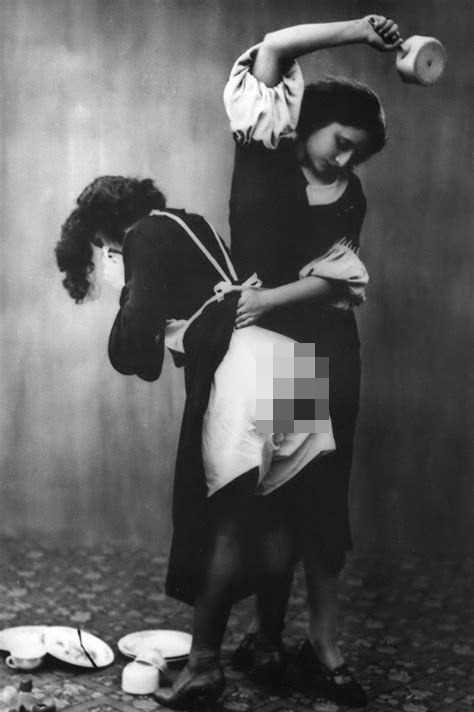 Women pose for a photo shoot in a French magazine in 1905. The French never did shy away from adult material and often had fully x-rated picture shoots or videos as soon as they could be produced. This would add to their adult clubs, even gay clubs, as they were quite open to sexual behaviors of all kinds. Their photos and films had no limits either, as this picture is clearly for a spanking fetish. The woman being spanked is playing a maid who broke some dishes. The French made pornographic material almost immediately after the invention of film was made, and marketed ever since. Other nations took up to 60 years before they would follow suit.
Women pose for a photo shoot in a French magazine in 1905. The French never did shy away from adult material and often had fully x-rated picture shoots or videos as soon as they could be produced. This would add to their adult clubs, even gay clubs, as they were quite open to sexual behaviors of all kinds. Their photos and films had no limits either, as this picture is clearly for a spanking fetish. The woman being spanked is playing a maid who broke some dishes. The French made pornographic material almost immediately after the invention of film was made, and marketed ever since. Other nations took up to 60 years before they would follow suit. -
2.
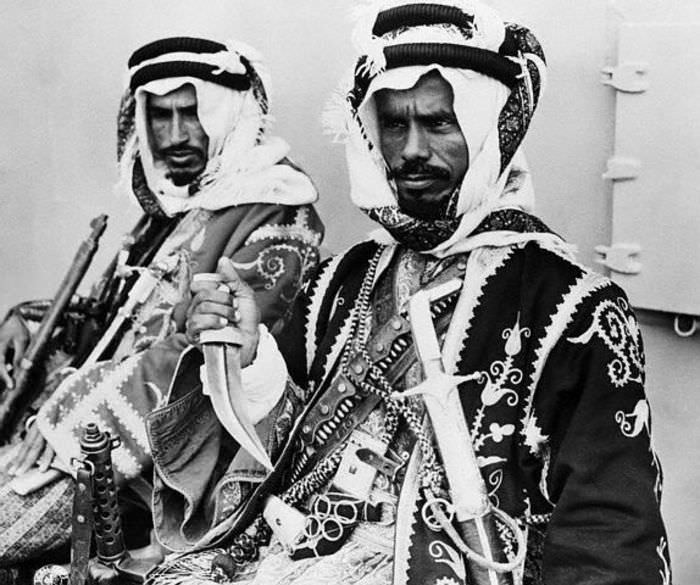 Royal bodyguards for King Abdulaziz of Saudi Arabia in 1947. One is showing off his dagger, which he carries with him along with a sword, a pistol, and a sub machine gun (the other appears to have a rifle). It is likely the sword and dagger would have only been used to punish someone, while the guns would only be needed if an actual attack on the King took place. By this time, the Saudi royalty, put in place by the British, were already becoming rich, as the first Saudi oil well opened in 1938.
Royal bodyguards for King Abdulaziz of Saudi Arabia in 1947. One is showing off his dagger, which he carries with him along with a sword, a pistol, and a sub machine gun (the other appears to have a rifle). It is likely the sword and dagger would have only been used to punish someone, while the guns would only be needed if an actual attack on the King took place. By this time, the Saudi royalty, put in place by the British, were already becoming rich, as the first Saudi oil well opened in 1938. -
3.
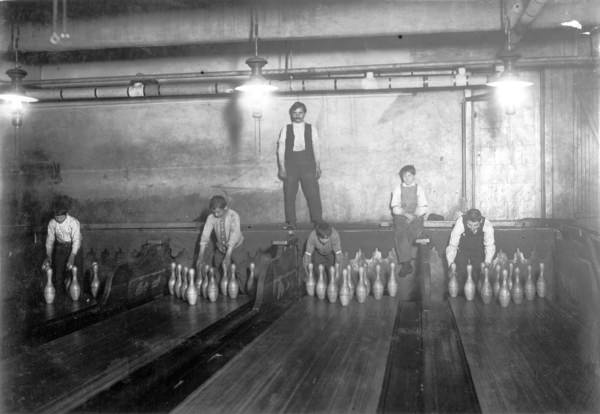 Young boys known as Pinsetters working at a bowling alley in Chicago, US in 1908. Many business owners actually hired children to do tedious jobs for incredibly low wages. Factories in particular exploited children. But many forget that even owners of games, shows, and sports hired children. Ballboys and girls in all sports is another example, which started as overused children working a low paying job but did eventually evolve to respected and even desired jobs for children today. Interesting note, Pinsetters existed easily into the 1950s before mechanized alleys took over.
Young boys known as Pinsetters working at a bowling alley in Chicago, US in 1908. Many business owners actually hired children to do tedious jobs for incredibly low wages. Factories in particular exploited children. But many forget that even owners of games, shows, and sports hired children. Ballboys and girls in all sports is another example, which started as overused children working a low paying job but did eventually evolve to respected and even desired jobs for children today. Interesting note, Pinsetters existed easily into the 1950s before mechanized alleys took over. -
4.
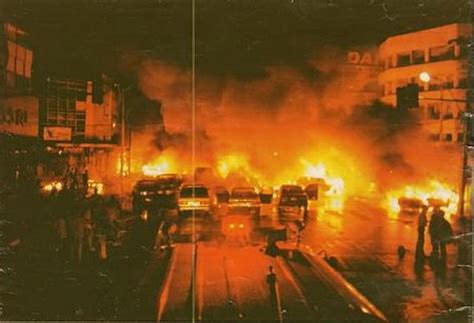 A fire blazes on during a gas explosion in Bangkok, Thailand in 1990. A liquid petroleum gas tanker truck crashed off an exit, and caused a massive explosion and fire that burned for a full day. It spread quickly, and 38 Buildings were destroyed. A total of 90 people died, and another 121 were injured. It was a terrible man made disaster and one of the worst ever resulting from a vehicle crash.
A fire blazes on during a gas explosion in Bangkok, Thailand in 1990. A liquid petroleum gas tanker truck crashed off an exit, and caused a massive explosion and fire that burned for a full day. It spread quickly, and 38 Buildings were destroyed. A total of 90 people died, and another 121 were injured. It was a terrible man made disaster and one of the worst ever resulting from a vehicle crash. -
5.
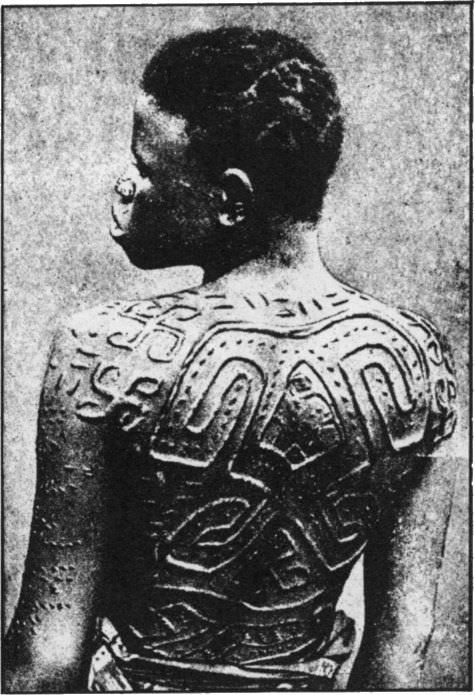 A tribal women shows off the scarification done to her in Belgian Congo in 1935. On both of her shoulders are the symbol of luck- Swastika, the Swastika has been used for thousands of years by many different cultures around the world way before the Germans ruined the meaning of the symbol. As for scarification, it is a way to beautify a person, and was often done in African Tribes of the Congo, Sudan, and surrounding areas. It was done both for men and women, and all over their bodies and faces. This practice still exists, but is not nearly as common.
A tribal women shows off the scarification done to her in Belgian Congo in 1935. On both of her shoulders are the symbol of luck- Swastika, the Swastika has been used for thousands of years by many different cultures around the world way before the Germans ruined the meaning of the symbol. As for scarification, it is a way to beautify a person, and was often done in African Tribes of the Congo, Sudan, and surrounding areas. It was done both for men and women, and all over their bodies and faces. This practice still exists, but is not nearly as common. -
6.
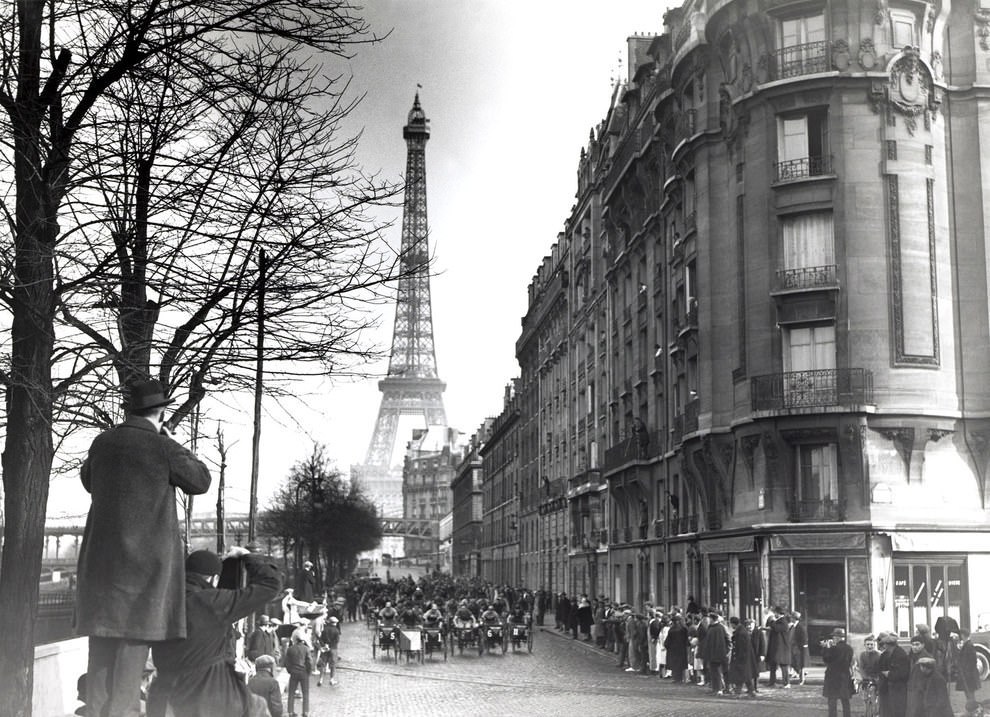 People watching a triporteurs race in Paris, France in 1924. As new inventions of transportation were created, even unconventional ones, races for those things also began. Often, as many would argue is still the case today, people would flock to see the utter failure of the participants and crashes that would occur. This is before television and film was readily available, and such entertainment was worth it to many.
People watching a triporteurs race in Paris, France in 1924. As new inventions of transportation were created, even unconventional ones, races for those things also began. Often, as many would argue is still the case today, people would flock to see the utter failure of the participants and crashes that would occur. This is before television and film was readily available, and such entertainment was worth it to many. -
7.
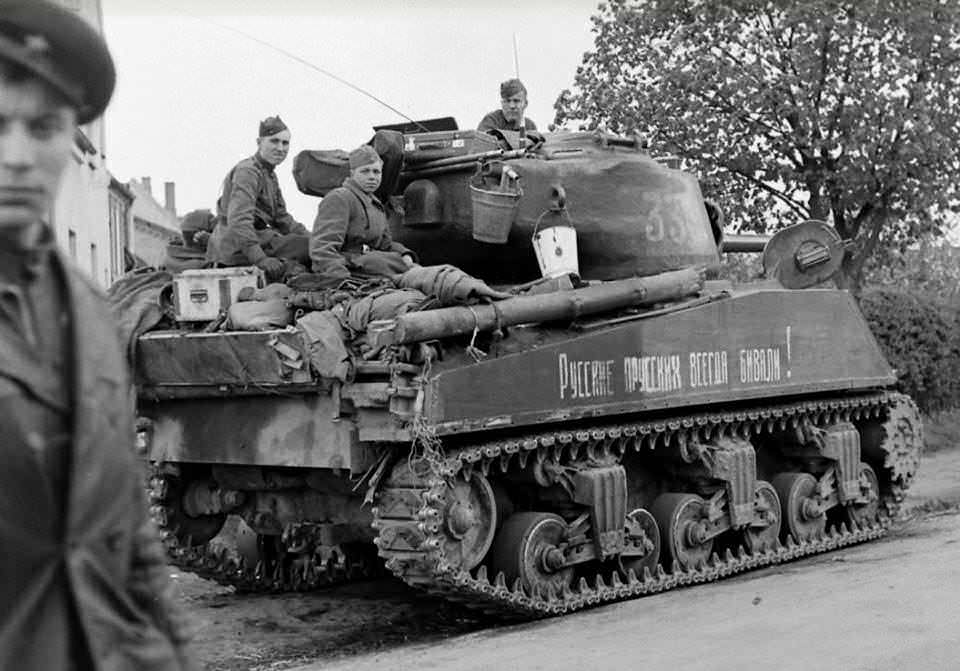 Russians on top of an American made Sherman Tank in Poland in 1945, six years after they invaded with the Nazis; this time Russians were against them. The Russians were beneficiaries of the lend-lease program which allowed American made weapons to be sent to the USSR to fight the Nazis. The Russians moved many of their factories further away from Europe trying to ensure manufacturing could continue in case of war, especially of weapons. Still it took nearly 3 years of war for the Soviets to be completely self sufficient with their weapons, and started reeling them off in huge numbers.
Russians on top of an American made Sherman Tank in Poland in 1945, six years after they invaded with the Nazis; this time Russians were against them. The Russians were beneficiaries of the lend-lease program which allowed American made weapons to be sent to the USSR to fight the Nazis. The Russians moved many of their factories further away from Europe trying to ensure manufacturing could continue in case of war, especially of weapons. Still it took nearly 3 years of war for the Soviets to be completely self sufficient with their weapons, and started reeling them off in huge numbers. -
8.
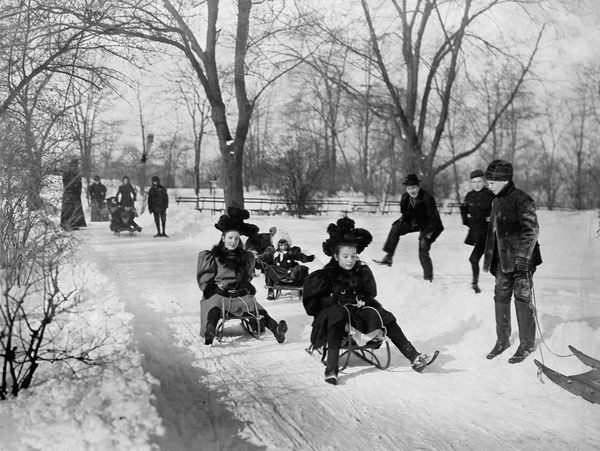 Children going sledding in New York City, US in 1900. Sledding is over a thousand years old, and was and still is used as a form to transport things across snow. The first sleds were from Nordic areas, and strong evidence shows often an animal would pull them to move items even back then. As easy as sleds are to make, hundreds of years ago they became more of a way for people to play on snow.
Children going sledding in New York City, US in 1900. Sledding is over a thousand years old, and was and still is used as a form to transport things across snow. The first sleds were from Nordic areas, and strong evidence shows often an animal would pull them to move items even back then. As easy as sleds are to make, hundreds of years ago they became more of a way for people to play on snow. -
9.
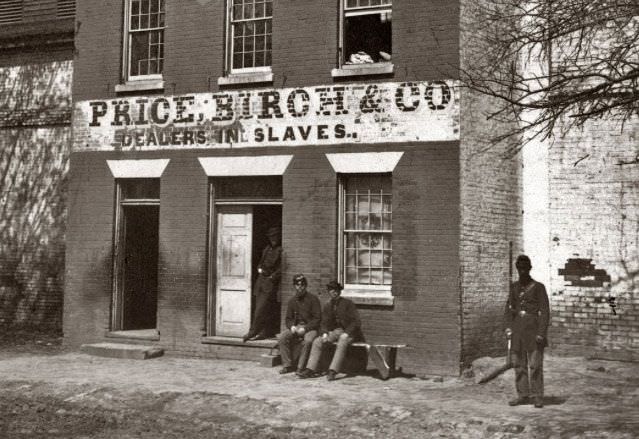 A slave pen after being shut down in Washington D.C. during the American Civil War. The slave trade was outlawed in the US in 1850 but slavery itself was not outlawed even in the capital until 1862, 1 year after the war started. That means as the Union Army was called up, organized, and eventually invaded the South to help free the slaves, the Capitol of the North still had legal slavery.
A slave pen after being shut down in Washington D.C. during the American Civil War. The slave trade was outlawed in the US in 1850 but slavery itself was not outlawed even in the capital until 1862, 1 year after the war started. That means as the Union Army was called up, organized, and eventually invaded the South to help free the slaves, the Capitol of the North still had legal slavery. -
10.
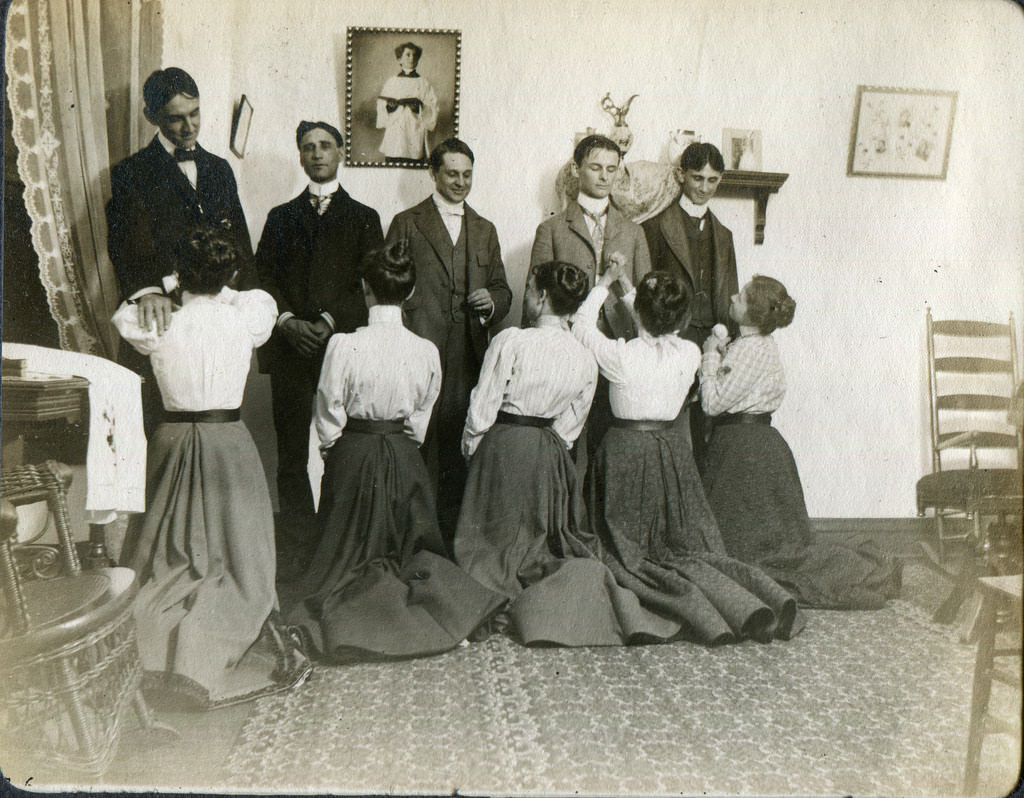 5 Women pose for a picture as they playfully ask for the affections of the men standing in London, England in 1892. Although this would appear as clean fun, many women of the time did not work, did not have the vote to have their voice heard, or overall even have much ability outside of the prospect of a quality marriage at the time, and would turn this kind of act into a real pursuit to marry proper and have a good life.
5 Women pose for a picture as they playfully ask for the affections of the men standing in London, England in 1892. Although this would appear as clean fun, many women of the time did not work, did not have the vote to have their voice heard, or overall even have much ability outside of the prospect of a quality marriage at the time, and would turn this kind of act into a real pursuit to marry proper and have a good life. -
11.
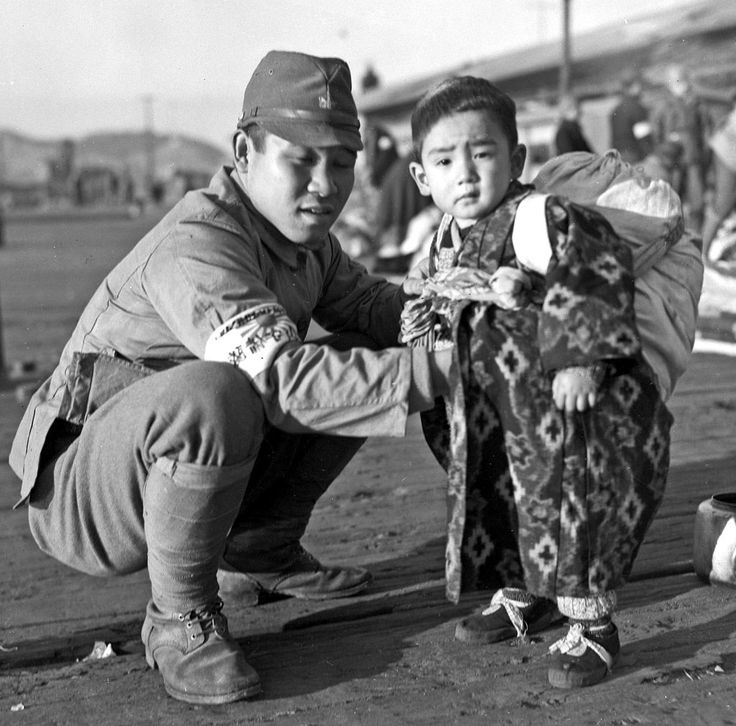 A Japanese soldier says goodbye to his son as he heads back to Japan after the war has ended in 1945. His son is with a Korean wife, but since he was in the imperial army and she is a Korean citizen, he is being sent back to Japan, away from his family. This was how it was with all other Japanese soldiers that were stationed in Korea. Personal requests involving established mixed families in Korea was ignored, despite Korea being part of Japan for 35 years, from 1910 to 1945, which of course caused many cases of integrated families.
A Japanese soldier says goodbye to his son as he heads back to Japan after the war has ended in 1945. His son is with a Korean wife, but since he was in the imperial army and she is a Korean citizen, he is being sent back to Japan, away from his family. This was how it was with all other Japanese soldiers that were stationed in Korea. Personal requests involving established mixed families in Korea was ignored, despite Korea being part of Japan for 35 years, from 1910 to 1945, which of course caused many cases of integrated families. -
12.
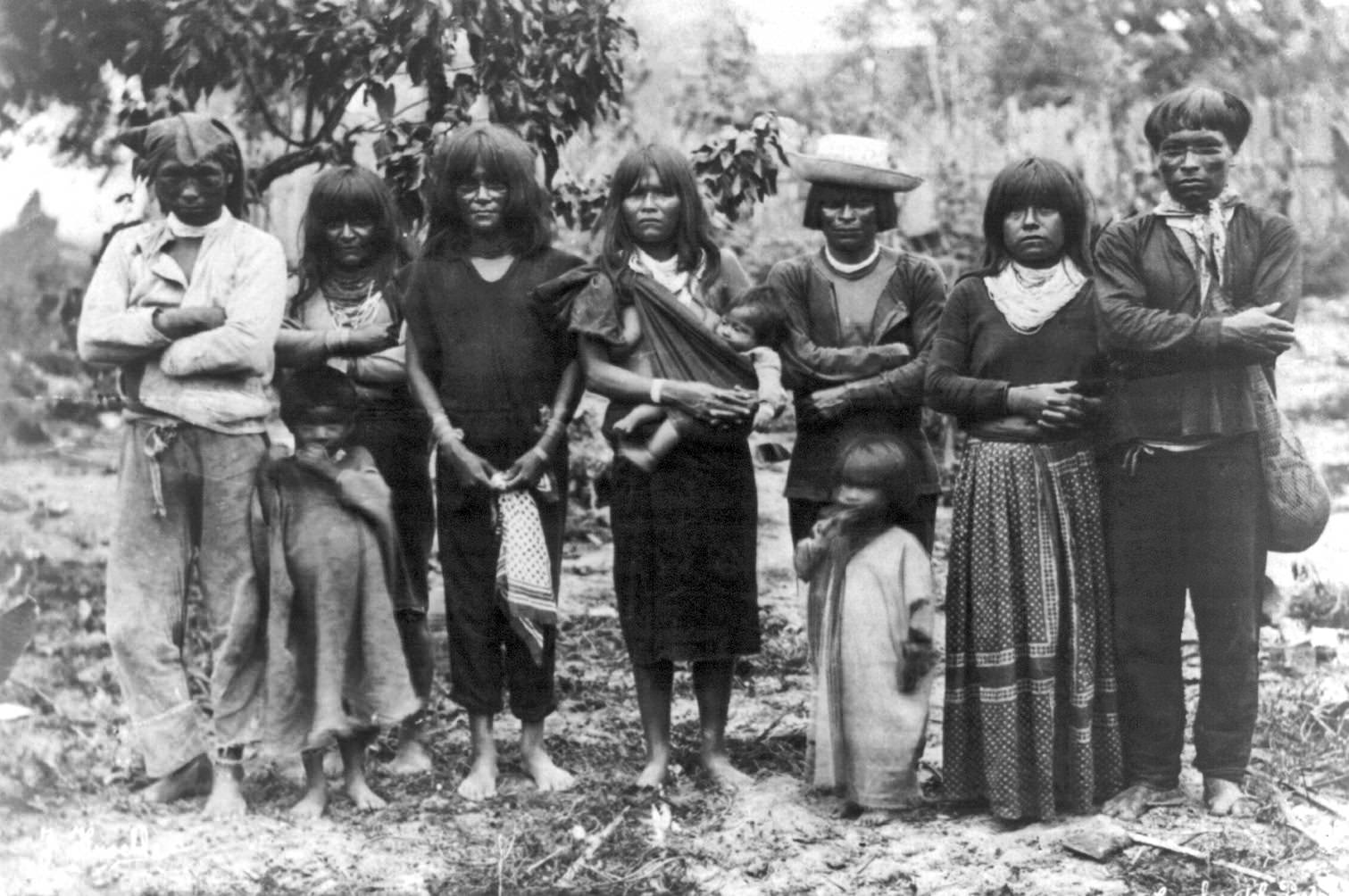 Native South American Indians pose for a picture with clothes given to them by the government somewhere in Brazil in 1922. Brazil had major plans to civilize the native population, and by any means necessary. This became very important as more discoveries of gold, silver, and other natural resources would be discovered on tribal lands. The Brazilian government forced the natives to move, integrate, and adapt, and if they did not, in some cases, violence would occur. This practice is sadly still technically ongoing, and certain tribes are still fighting against the Brazilian government on various things almost all relating to their claim of ownership of their own lands.
Native South American Indians pose for a picture with clothes given to them by the government somewhere in Brazil in 1922. Brazil had major plans to civilize the native population, and by any means necessary. This became very important as more discoveries of gold, silver, and other natural resources would be discovered on tribal lands. The Brazilian government forced the natives to move, integrate, and adapt, and if they did not, in some cases, violence would occur. This practice is sadly still technically ongoing, and certain tribes are still fighting against the Brazilian government on various things almost all relating to their claim of ownership of their own lands. -
13.
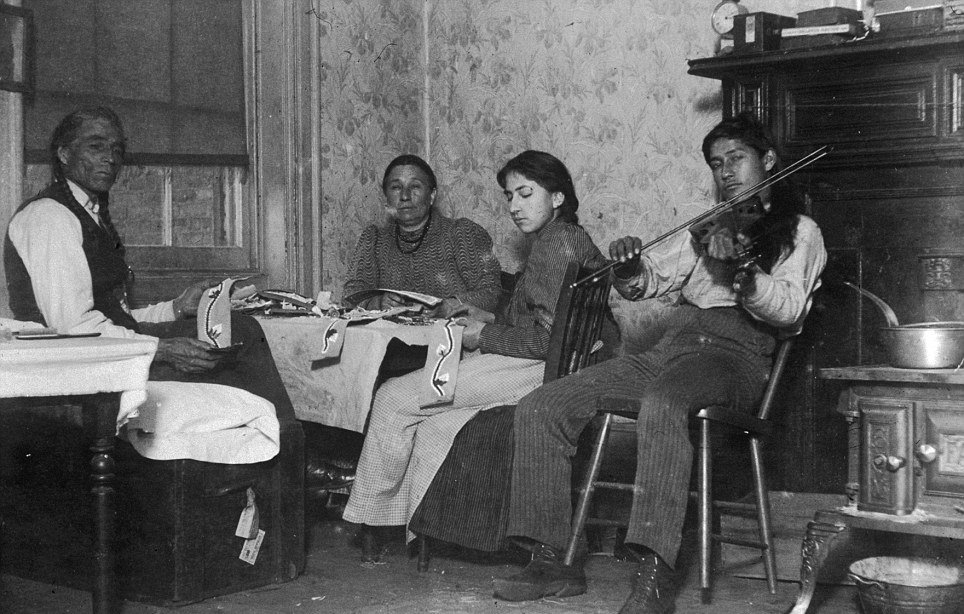 A Native American, Mountain Eagle, and his family make handicrafts while one son plays violin in their tenement at 6 Beach Street in this image taken in New York City, US in 1895. NYC was the center for all immigrants coming to the US on the East Coast for nearly 100 years. But many do not realize that when the US relocated Native Americans, some also went to NYC. It was an area so mixed that such people could blend in, avoiding all the problems that could come from mixing with other Americans. This was based on peoples false ideas of Native Americans the newspapers would peddle during the Indian Wars. That all happened when the US forced them off their lands during the Western Migration after The Civil War all the way up until the last tribes capitulated in the 1890s.
A Native American, Mountain Eagle, and his family make handicrafts while one son plays violin in their tenement at 6 Beach Street in this image taken in New York City, US in 1895. NYC was the center for all immigrants coming to the US on the East Coast for nearly 100 years. But many do not realize that when the US relocated Native Americans, some also went to NYC. It was an area so mixed that such people could blend in, avoiding all the problems that could come from mixing with other Americans. This was based on peoples false ideas of Native Americans the newspapers would peddle during the Indian Wars. That all happened when the US forced them off their lands during the Western Migration after The Civil War all the way up until the last tribes capitulated in the 1890s. -
14.
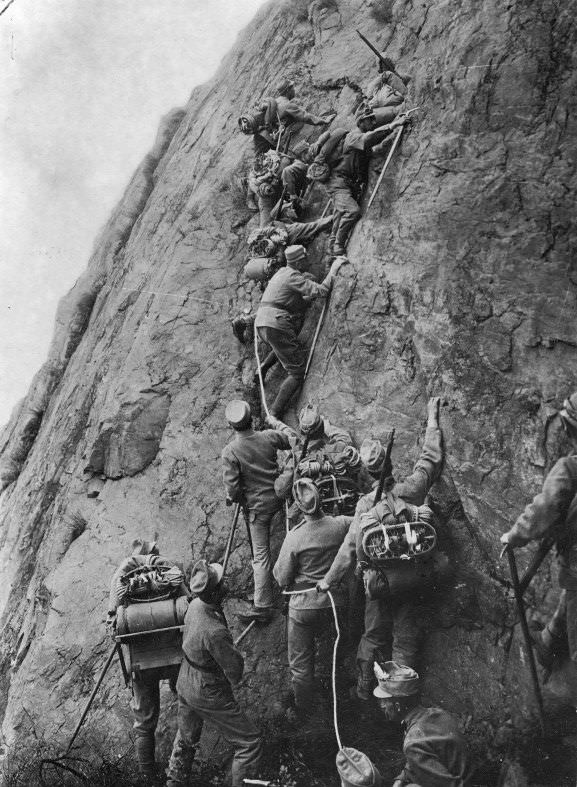 An Italian Alpine Unit scales a cliff during the Italian Campaign (or Mountain War) in 1915. During WWI, the Italians were on the allies side, and used these units to get over mountains and cliffs to create a second front against Austro-Hungary. The mountains are in Northern Italy, and posed a natural border. Moving units over them rather than around them helped the Italians gain some ground on their enemy. WWI had many different campaigns and fronts, causing different methods to maneuver in order to possibly flank an enemy. The Italians going over mountains on foot though is often forgotten.
An Italian Alpine Unit scales a cliff during the Italian Campaign (or Mountain War) in 1915. During WWI, the Italians were on the allies side, and used these units to get over mountains and cliffs to create a second front against Austro-Hungary. The mountains are in Northern Italy, and posed a natural border. Moving units over them rather than around them helped the Italians gain some ground on their enemy. WWI had many different campaigns and fronts, causing different methods to maneuver in order to possibly flank an enemy. The Italians going over mountains on foot though is often forgotten. -
15.
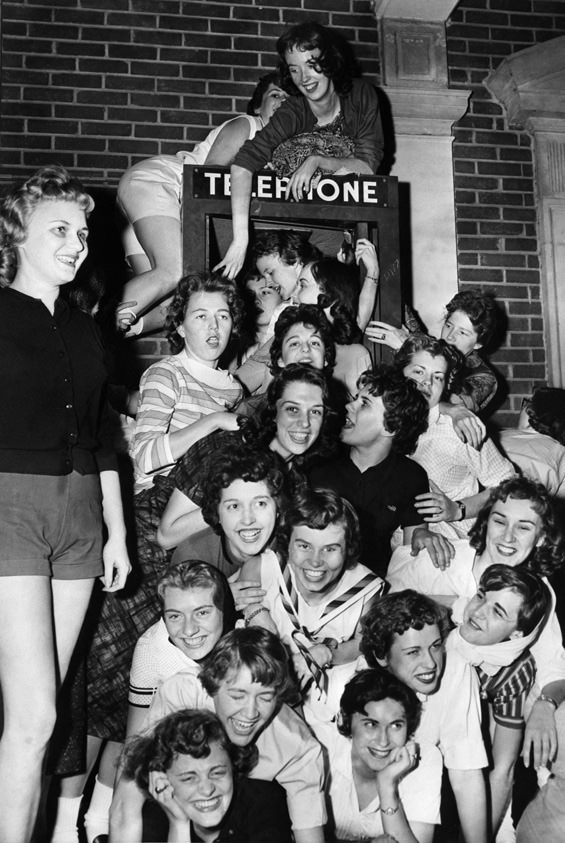 26 Sorority girls attempt to cram into a single phone booth at Memphis State University, TN, US in 1959. In the late 1950s, early 1960s, this unique college craze hit campuses where people tried to fit as many people into a phone booth as possible. Some would record the event and send it into magazines, where Life and Time Magazine would publish it, piggy backing onto the odd craze.
26 Sorority girls attempt to cram into a single phone booth at Memphis State University, TN, US in 1959. In the late 1950s, early 1960s, this unique college craze hit campuses where people tried to fit as many people into a phone booth as possible. Some would record the event and send it into magazines, where Life and Time Magazine would publish it, piggy backing onto the odd craze. -
16.
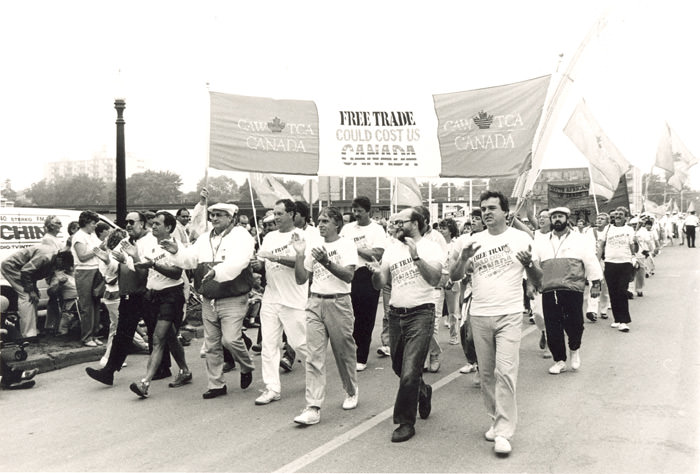 Protesters march against free trade negotiations between Canadian Prime Minister Brian Mulroney and US President Ronald Reagan in Toronto, Canada in 1985. As Japanese products became cheaper and superior to their US counterparts in the 1980s, the US began to suffer economically, especially with jobs in electronics and cars, causing factories to shut down and inflation throughout North America. Canada had higher inflation rates, and fears of their own issues arose. After Mulroney and Reagan opened talks to free trade across North America, fears persisted on what Canadians would lose to help the US regain its own losses. Thousands of Canadians made many protest marches, but eventually an agreement was struck in 1987 between the 2 countries and went into effect in 1988, known as the Canada–United States Free Trade Agreement (CUSFTA).
Protesters march against free trade negotiations between Canadian Prime Minister Brian Mulroney and US President Ronald Reagan in Toronto, Canada in 1985. As Japanese products became cheaper and superior to their US counterparts in the 1980s, the US began to suffer economically, especially with jobs in electronics and cars, causing factories to shut down and inflation throughout North America. Canada had higher inflation rates, and fears of their own issues arose. After Mulroney and Reagan opened talks to free trade across North America, fears persisted on what Canadians would lose to help the US regain its own losses. Thousands of Canadians made many protest marches, but eventually an agreement was struck in 1987 between the 2 countries and went into effect in 1988, known as the Canada–United States Free Trade Agreement (CUSFTA). -
17.
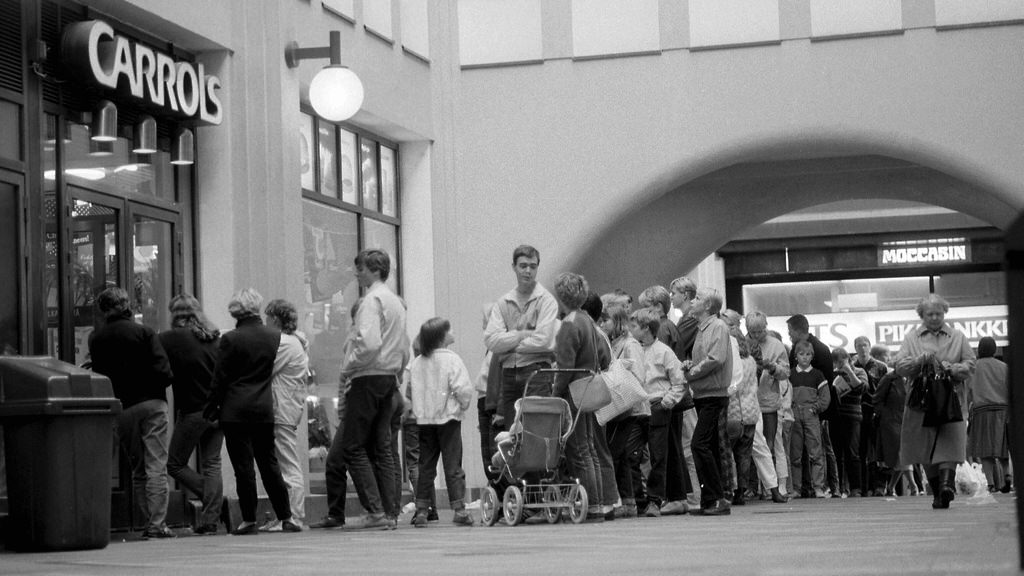 A huge line waits to get food from Carrols in Helsinki, Finland in 1980. Carrols Restaurant Group was a worldwide fast food chain that converted to Burger King in the 1970s in the US and North America, but stayed as Carrols in Scandinavia and Eastern Europe. Fast food chains were not as plentiful in Finland like other nations like the US, Japan, and Canada, so it wasn't hard to see massive lines like this build up just to get Carrols equivalent of a Whopper.
A huge line waits to get food from Carrols in Helsinki, Finland in 1980. Carrols Restaurant Group was a worldwide fast food chain that converted to Burger King in the 1970s in the US and North America, but stayed as Carrols in Scandinavia and Eastern Europe. Fast food chains were not as plentiful in Finland like other nations like the US, Japan, and Canada, so it wasn't hard to see massive lines like this build up just to get Carrols equivalent of a Whopper. -
18.
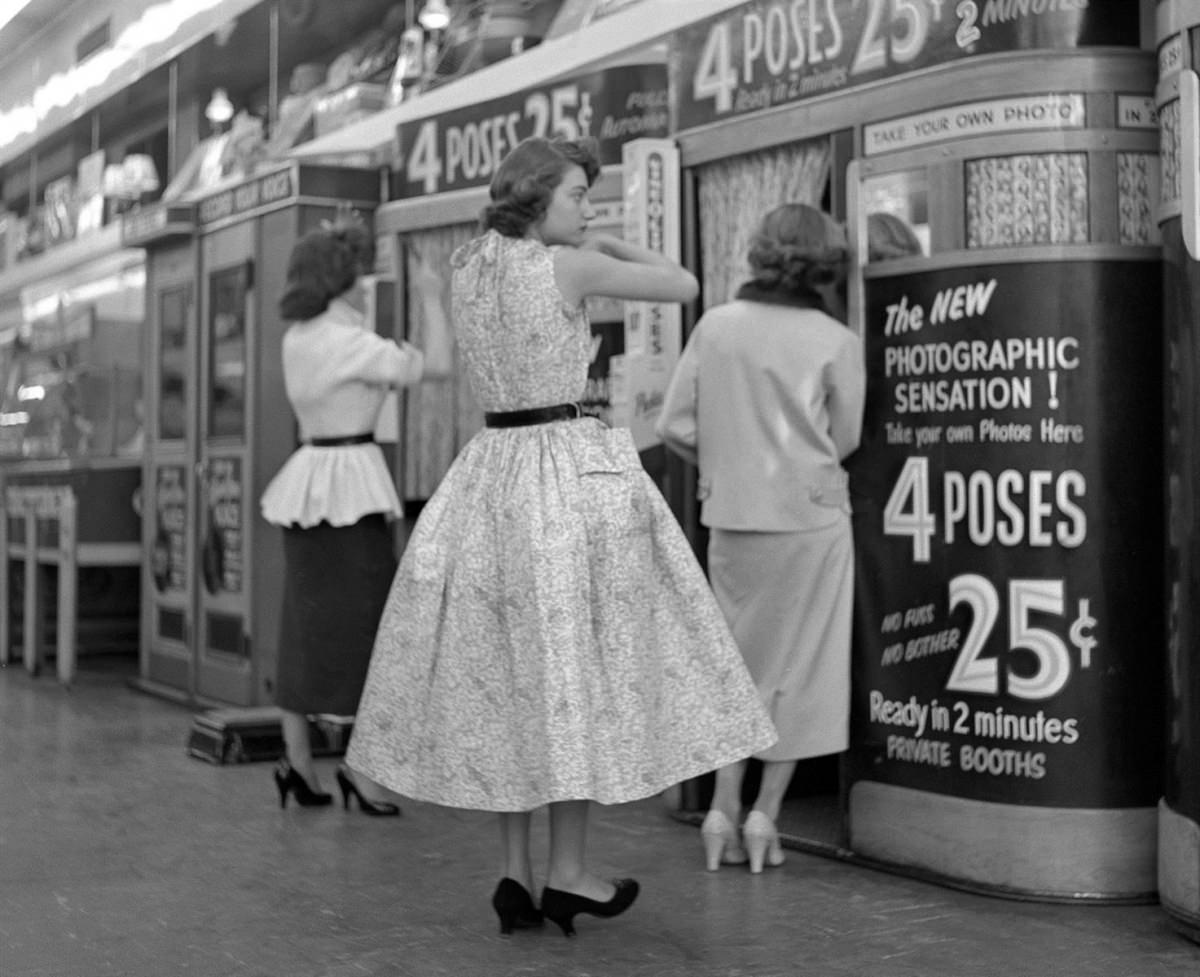 Women prepare to use picture booths for professional style pictures in New York City, US in 1955. Such pictures would be used to get noticed for a variety of jobs. Most would probably attribute this to creating a form of a portfolio for acting of some kind.
Women prepare to use picture booths for professional style pictures in New York City, US in 1955. Such pictures would be used to get noticed for a variety of jobs. Most would probably attribute this to creating a form of a portfolio for acting of some kind. -
19.
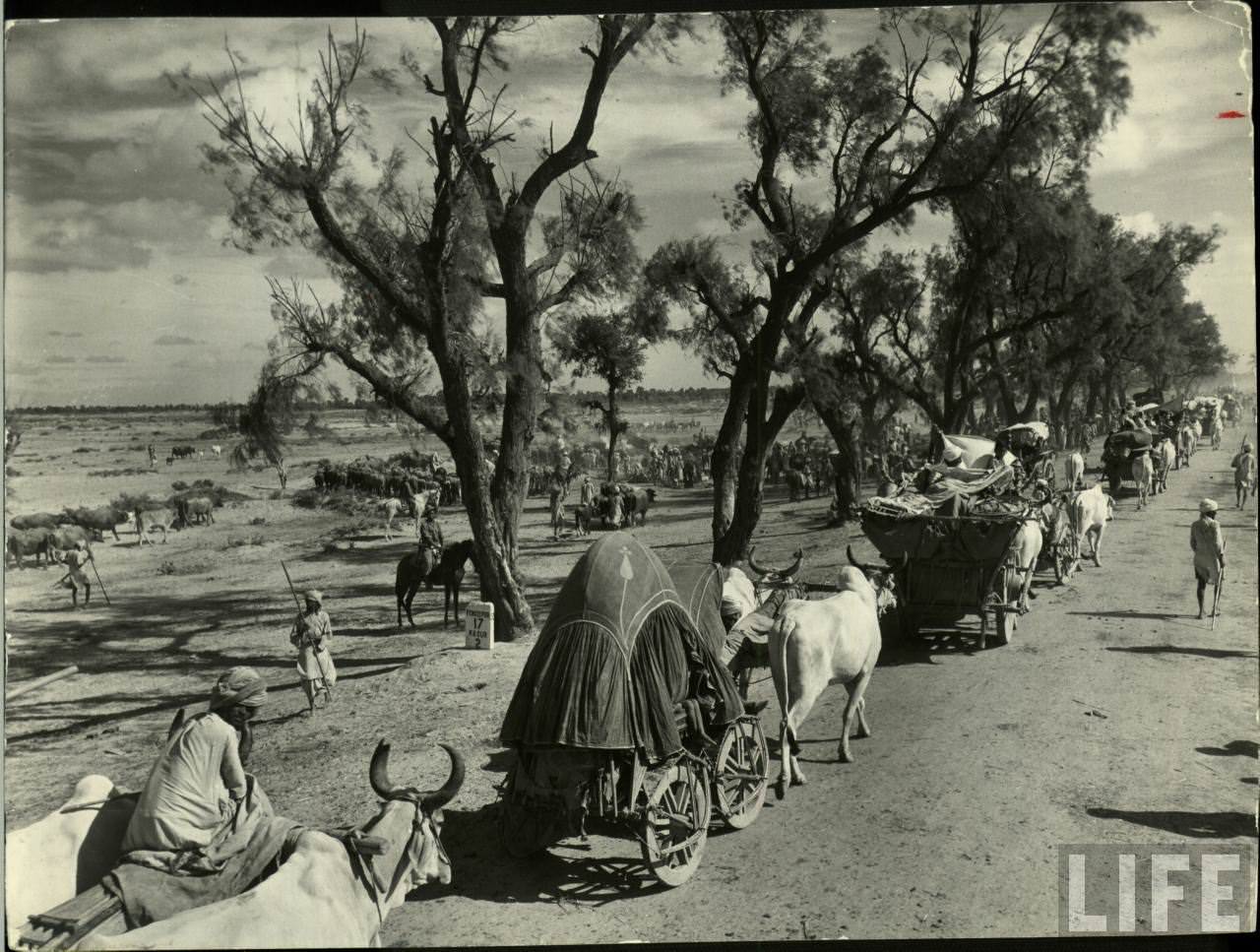 Hindu's follow a road during the partition of India after gaining independence from Britain in 1947. Following being given their freedom, the former British colony of India was split into different nations. As many of the populace truly hated each other, one of the largest mass migrations in history took place, and people moved to the new lands based on backgrounds and faiths. During this time, some 12 million people moved from their homes to the newly created countries. Rioting, fights, and crimes became rampant during the confusion and was nearly impossible to contain during the chaotic moves. Diseases, starvation and dehydration also was brutal. Some 500,000 people are estimated to have died during this time, and remember, this was after they had gained independence and a peace with the UK.
Hindu's follow a road during the partition of India after gaining independence from Britain in 1947. Following being given their freedom, the former British colony of India was split into different nations. As many of the populace truly hated each other, one of the largest mass migrations in history took place, and people moved to the new lands based on backgrounds and faiths. During this time, some 12 million people moved from their homes to the newly created countries. Rioting, fights, and crimes became rampant during the confusion and was nearly impossible to contain during the chaotic moves. Diseases, starvation and dehydration also was brutal. Some 500,000 people are estimated to have died during this time, and remember, this was after they had gained independence and a peace with the UK. -
20.
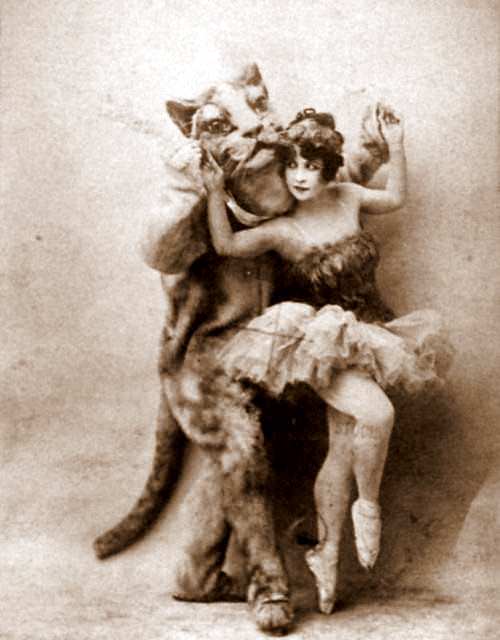 A ballerina poses with a character from their show sometime in the 1890s in Russia. The Russian ballet scene was massive in the late 1800s and early 1900s, showcasing top talent and performance shows across Europe. Some of the biggest stars of the time were Ballerinas, with their pictures everywhere and playing at major venues in front of nothing but upper class and royalty mostly in Europe and Russia, but sometimes in the US and Northern Africa.
A ballerina poses with a character from their show sometime in the 1890s in Russia. The Russian ballet scene was massive in the late 1800s and early 1900s, showcasing top talent and performance shows across Europe. Some of the biggest stars of the time were Ballerinas, with their pictures everywhere and playing at major venues in front of nothing but upper class and royalty mostly in Europe and Russia, but sometimes in the US and Northern Africa.
- REPLAY GALLERY
-
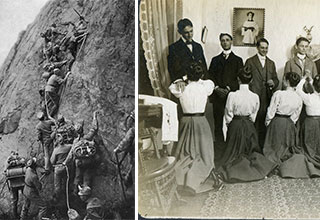
- 20 Fascinating And Rare Photos From The Past
- NEXT GALLERY
-

- 26 People So Dumb It Hurts
Women pose for a photo shoot in a French magazine in 1905. The French never did shy away from adult material and often had fully x-rated picture shoots or videos as soon as they could be produced. This would add to their adult clubs, even gay clubs, as they were quite open to sexual behaviors of all kinds. Their photos and films had no limits either, as this picture is clearly for a spanking fetish. The woman being spanked is playing a maid who broke some dishes. The French made pornographic material almost immediately after the invention of film was made, and marketed ever since. Other nations took up to 60 years before they would follow suit.
20/20
1/20
Categories:
Wow


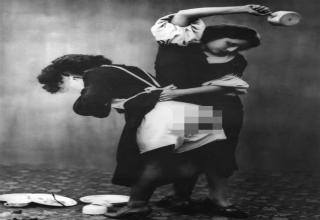




5 Comments